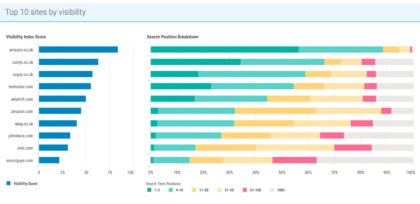Competitor Analysis: how to conduct a Competitor Analysis
25 Jan 2024|4 MIN READ
Analysing your own performance only tells half the story. You’ve got to carry out a thorough competitor analysis to fully understand your market.
What is competitor analysis?
Competitor analysis is the practice of evaluating the other players in your market and gathering performance data with the goal to enrich your marketing and product strategy.
Why is competitor analysis important?
Competitor research is essential for a couple of reasons:
- Discover your competitors: simply understanding who is operating in the same space as you and targeting the same audience brings huge insight into the kind of content you should be serving. You can see what they’re doing right and how you might emulate their successes.
- Identifying opportunity: you can stumble on some real gems whilst spying on your competitors; you’ll be able to identify potential partners, resellers, advocates and even PR opportunities.
Unlimited competitor analysis
How to do a competitor analysis
Pi has a suite of advanced competitor analysis tools, each designed to empower you with valuable insights.
Let’s delve into the capabilities of Competitor Discovery, Share of Voice Leaders, Share of Voice Timeline, and Visibility Indexes to elevate your competitive intelligence.
Competitor Discovery tool
Conduct swift analyses of the latest data to understand the competitor landscape.
By selecting categories, Competitor Discovery identifies the brands with top-performing websites in your chosen niche. From there, dive into keyword-driven insights, unveiling websites with the most visibility. It also breaks down the performance of each website across positions 1-3, 4-10, 11-20, and so on.
With Competitor Discovery you’ll gain a comprehensive view of the market, discovering the categories and sub-categories that propel top sites to success.
Catch up on our Product Demo Webinar Series where John Barket, Head of Solutions here at Pi demonstrates a step-by-step guide to Pi’s core competitor analysis tools.
Share of Voice Leaders
Share of voice is all about understanding the value of keywords as a whole.
Pi’s Share of Voice metric takes all of the keywords from your categories and sub-categories and applies a value to each keyword based on search volume, CPC rates, and competition. Learn more about how SOV is calculated here.
With Pi’s Share of Voice Leaders, you can quickly see how your competitors perform in the market based on share of voice. You’ll also see how this market share is built up based on category contribution.
See who’s winning and losing based on your target categories.
Share of Voice Timeline
Track changes in a competitor’s market share over time with the Share of Voice Timeline tool.
Visualize market fluctuations, predict future trends, and observe how your competitors fare during algorithm updates.
Visibility Indexes
Explore daily activities impacting both you and your competitors with Visibility Indexes.
Unlike Share of Voice tools, treat each keyword equally to paint a holistic picture of a website’s health.
Drill down to granular levels, analyzing performance in specific categories and sub-categories.
Compare competitor content
Once you’ve got a list of your competitors you can start to look at their content. What type of content are they creating? Do they do a lot of case studies? Videos? Audio?
Think about how this compares to your SEO content; are there any gaps in your content? What could you invest in to compete? What are they doing well that you can learn from?
Analyse the SERP landscape and identify the features that are returning for your most valuable search terms. At Pi, our SERP Feature tracking tools reveal which features have visibility in your space and also shows who is ranking for them! Track your performance and your competitors in rich features:

Pi Platform SERP Matrix | 2-hourly
If you’re a product lead company, you can also use this phase to identify new product ideas – can you build on their product or make it better?
Competitor SEO analysis
After looking at how their content compares to yours, it’s time to go into the detail of their offering. Specifically, the SEO structuring of their content.
You want to optimise your site to outperform your competitors in search engine results, so you’ll pull more traffic. So studying their SEO, and your own, is essential.
Here are some SEO practices to consider:
- H1s and H2s
- Metadata
- Keyword usage
- Alt text?
So you can learn from your competitors’ shortcomings and evaluate their overall SEO performance.
Finding value in your research
Once you’ve conducted your research, you need to organise it and create actionable points.
You may have gathered all the data but now’s the time to bring in the content, SEO and social teams to share your wealth of knowledge. You can categorise your findings under their specific departments, breaking it down so it’s easier to implement with certain teams taking different responsibilities.
Track your performance
Never miss a post
Join our mailing list and have our SEO news delivered straight to your inbox.
Never miss a post
Join our mailing list and have our SEO news delivered straight to your inbox.




